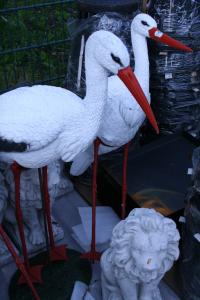Not a single pink, plastic flamingo was to be seen in the town of Büdelsdorf in Northern Germany, but we did see some mischievous
aiapäkapikud (garden gnomes) and chanced upon these leggy creatures in the town’s
garten centre. Is the
valge-toonekurg (white stork,
weißstorch in German) idealised because of its status as the bearer of babes, or because Germany’s landscape has become “übercultured” and -cultivated, with its wild creatures heading for cover elsewhere?
The majority of visitors taking advantage of Eesti’s burgeoning
ökoturism (eco-tourism industry) are reportedly Germans, who come up north to marvel at the unspoiled wilderness. Thankfully Germany is far from stork-
frei, yet 3000 of its total 3400 mating pairs nest in the former (“wilder?”) East Germany. Lithuania has the highest known density of this species in the world and Eesti is its northernmost breeding range. The white stork is also the national bird of Germany, Poland and Lithuania.
We were still fortunate to witness fauna a Tallinn-dweller definitely doesn’t see every day, including a
siil (hedgehog), lots of
halljänesed (brown hares),
kaelustuvid (wood pigeons) and
laugud (coots) also known as
roo-, järve- or
vesikana (reed, lake or water hen). And the stork can watch your
garten grow for a mere 27 euros. That’s $38 or 422 Eesti krooni! The high price of wildlife conservation.
Photo and text: Riina Kindlam, Tallinn
